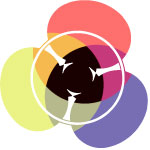A possible explanation // Graphics // Tools // Resources
1) At the cross-road of the intelligible and the sensible world ?
We’re naturally lazy : as the falling water we prefer to take the easier path. And the vision is one of our most used sense (imagine you’re blind and you « see » that’s a basis for our interactions in the society).
So when a thing is visually explicit it’s better. Like when we use metaphor verbally (as the « drop of water » just above).
A picture is worth more than thousand word, and its almost universal without the barrier of the language (« almost » because a minimum of knowledges are needed to decipher the meaning).
Information graphics = visual cognition = a kind of Synesthesia ?
Where complex information needs to be explained quickly and clearly
When raw data or abstractive concept are made tangibles, they became limpid in their whole perception.
Elementary scheme of the conversion of data into wisdom.Source: Graphic by the author adapted from the one present in the article « An Overview of Understanding » by N. Shedroff in the book Information Anxiety 2 by R.S. Wurman. (infovis.net)
At the beginning, I wanted to make this post after the discovery of Freemind, an application to build mind maps.
I was struggled with a complex thinking, and this tool helped me to organize it. (link at the end)
After that I noticed more and more good things related to this topic. So I made this list, for examples, tools, other things… Enjoy 🙂
2) Let’s see some examples:
The Conversation Prism
Wine Flavor Viz
The Spectrum of User Experience
Map of the Future
Planisfero Roma, Stalker 1955
The Biggest Story of Our Time
The Internet Mapping Project by Kevin Kelly (via graphism.fr)
Please design a logo for me. With pie charts. For free. (fun to read)
Lord of the Ring, visualized
The hierarchy of digital distraction
Walt Disney’s Creative Organization Chart
Visualizing information flow in science
A periodic table of visualization methods
The most impressive classification I’ve ever seen. With an example for each methods.
And if you are still thirsty:
3) Tools :
Specially for Twitter
For searches:
4) Links and resources :
Specialized websites
Some more lists:
Thanks for reading !
The organization of this post evolve permanently, in order to classify and improve the examples and links related to visual thinking.



















